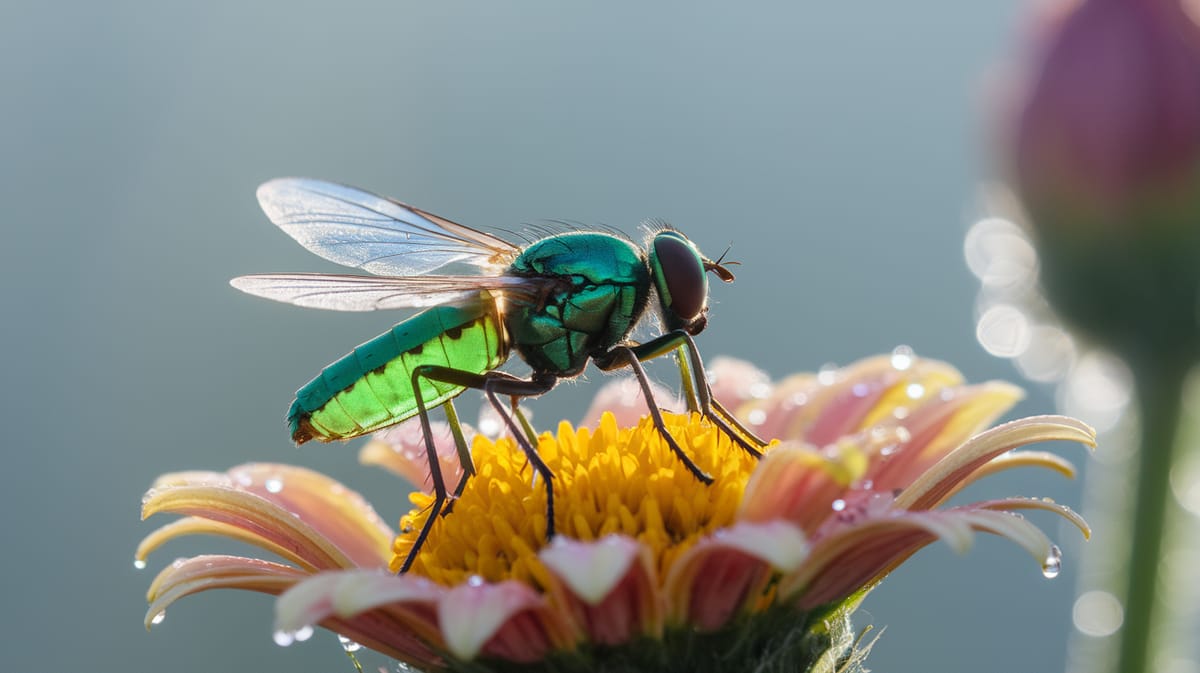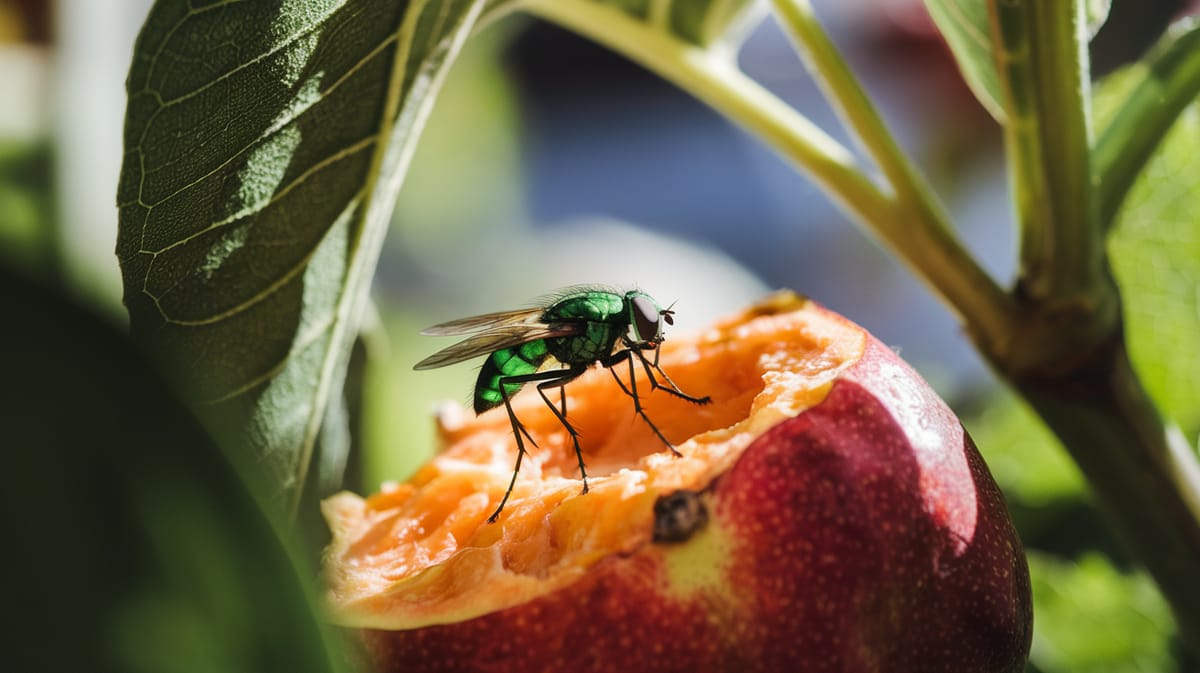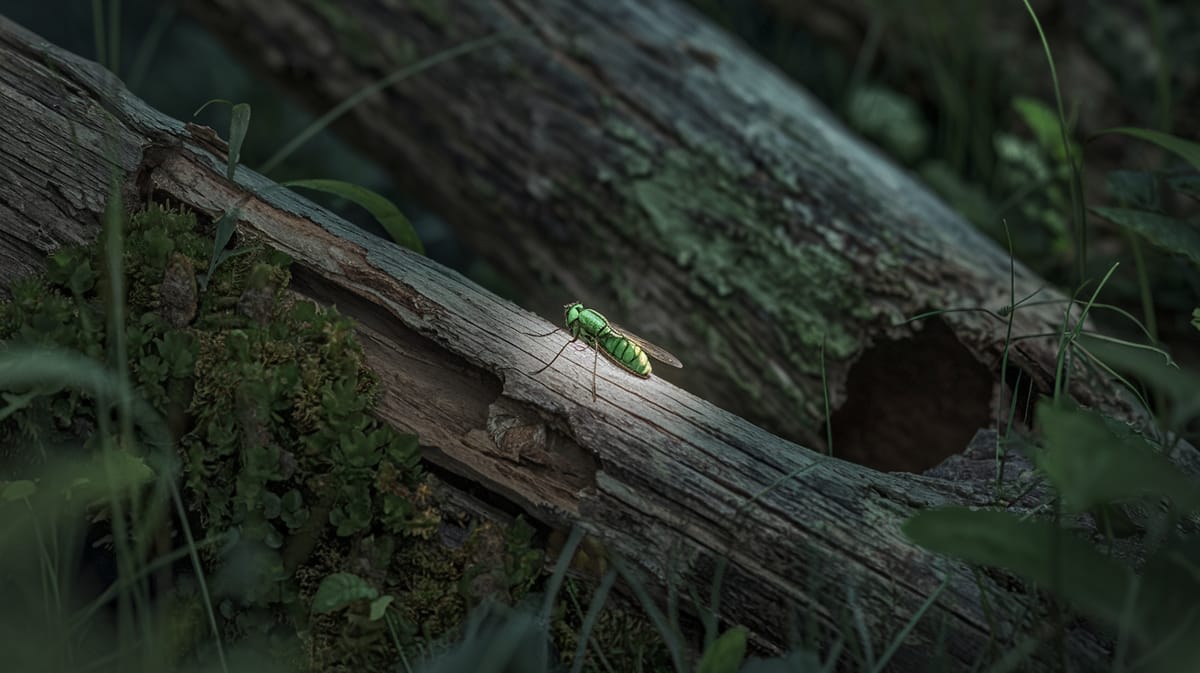Greenbottle Fly
Shimmering in vibrant metallic green, the Greenbottle Fly plays a vital role in nature as an efficient decomposer and pollinator. Its keen sense of smell aids in locating food sources.

Key Insights at a Glance
Did You Know?
Taxonomy & Classification
Greenbottle flies exhibit metallic green bodies and play vital roles in decomposition, aiding ecosystems through nutrient recycling. Let's understand the evolutionary journey and classification of these remarkable decomposers.
Species Diversity
Lucilia comprises around 30 species globally, thriving in diverse environments due to their adaptability and scavenging behaviors.
Evolutionary Adaptations
Evolving over millions of years, these flies have adapted to detect decaying matter efficiently, ensuring survival even in fluctuating conditions.
Lifecycle and Growth
A remarkable journey of transformation from Egg to Adult.
Egg
Eggs are laid on decaying matter, hatching quickly to provide larvae with immediate access to food sources.
Larva
Larvae, known as maggots, feed voraciously on decaying organic material, growing rapidly before seeking a safe place to pupate.
Pupa
Pupae remain inactive as they undergo metamorphosis, transitioning from a larval to an adult form inside a brown, hardened shell.
Adult
Adults emerge fully formed, capable of flight and reproduction, often feeding on nectar and other sugary substances.
Dietary Habits
A scavenger with keen senses, this insect thrives on decaying organic matter, making it vital in nutrient recycling.
| DIET TYPE | DESCRIPTION |
|---|---|
| Primary Diet | Primarily consumes carrion and decaying animal tissues, aiding in decomposition processes. |
| Secondary Diet | Feeds on excrement and garbage, supplementing its diet with easily accessible organic waste. |
| Occasional | Occasionally consumes plant nectar and pollen, especially when other food sources are scarce. |

Behaviour and Adaptations
Discover the fascinating adaptations that make the Greenbottle Fly a remarkable survivor in diverse environments.
Rapid Reproduction
High egg-laying rates ensure rapid population growth and survival.
Efficient Decomposition
Plays a key role in breaking down organic matter, aiding nutrient recycling.
Acute Vision
Compound eyes provide a wide field of view, enhancing environmental awareness.
Ecosystem Impact
Key roles of Greenbottle Flies in maintaining ecological balance.
Decomposition Agents
Aid in breaking down organic matter, recycling nutrients back into the soil.
Pollination Partners
Visit flowers for nectar, assisting in plant pollination processes.
Food Web Component
Serve as a food source for various birds and small mammals.
Conservation Challenges
Addressing the pressing threats to Greenbottle Fly populations.
Chemical Exposure
Pesticides harm Greenbottle Fly larvae and reduce their food sources.
Habitat Loss
Urbanization and agriculture reduce breeding and feeding sites for Greenbottle Flies.
Climate Change
Temperature shifts disrupt Greenbottle Fly life cycles and food availability.
Frequently Asked Questions
How long do Greenbottle Fly live?
Greenbottle flies typically live for about two to three weeks. Their lifespan can vary based on environmental conditions like temperature and food availability. The life cycle includes egg, larva, pupa, and adult stages, with the adult stage being the shortest.
What do Greenbottle Fly eat?
Greenbottle flies primarily feed on decaying organic matter, including dead animals and feces. They are also attracted to garbage and carrion. The larvae, known as maggots, feed on decomposing tissue, playing a crucial role in the ecosystem by aiding decomposition.
Are Greenbottle Fly poisonous?
Greenbottle flies are not poisonous. However, they can carry bacteria and other pathogens due to their feeding habits, which may lead to contamination of food and surfaces. Proper hygiene and sanitation can help minimize any potential health risks associated with them.
Are Greenbottle Fly endangered?
Greenbottle flies are not considered endangered. They are widely distributed and abundant in many regions, thriving in various environments. Their adaptability and reproductive rate contribute to their stable population status, ensuring they are not at risk of endangerment.
What do Greenbottle Fly symbolize?
Greenbottle flies often symbolize transformation and change due to their role in decomposition and recycling nutrients. In some cultures, they are seen as symbols of death and decay, but they also represent renewal and the natural life cycle in the ecological context.
Do Greenbottle Fly bite?
Greenbottle flies do not bite humans or animals. They lack the mouthparts necessary for biting. Instead, they feed on liquids and soft materials, using their sponging mouthparts to consume nutrients from decaying organic matter and other moist surfaces.
What color are Greenbottle Fly?
Greenbottle flies are known for their metallic green bodies, which can sometimes have blue or bronze tones. Their iridescent coloring makes them easily identifiable and distinguishes them from other fly species. The adults also have red eyes and clear wings.
Does a Greenbottle Fly have wings?
Yes, a Greenbottle fly has wings. As adults, they possess a single pair of translucent wings, which they use for flying. These wings enable them to travel in search of food sources, mates, and suitable environments for laying eggs.
What does a Greenbottle Fly look like?
Greenbottle flies are medium-sized with metallic green bodies, red eyes, and clear wings. They have three pairs of legs and distinct bristles on their bodies. Their striking coloration and size help differentiate them from other common fly species.
Is a Greenbottle Fly an insect?
Yes, a Greenbottle fly is an insect. It belongs to the order Diptera, which includes true flies. Like all insects, they have a three-part body (head, thorax, abdomen), six legs, and one pair of wings, meeting the criteria for classification as an insect.
Related Insects
Discover insects with similar characteristics to Greenbottle Fly - including shared habitats, diets, and taxonomic classifications
Share this profile
Help others discover Greenbottle Fly
